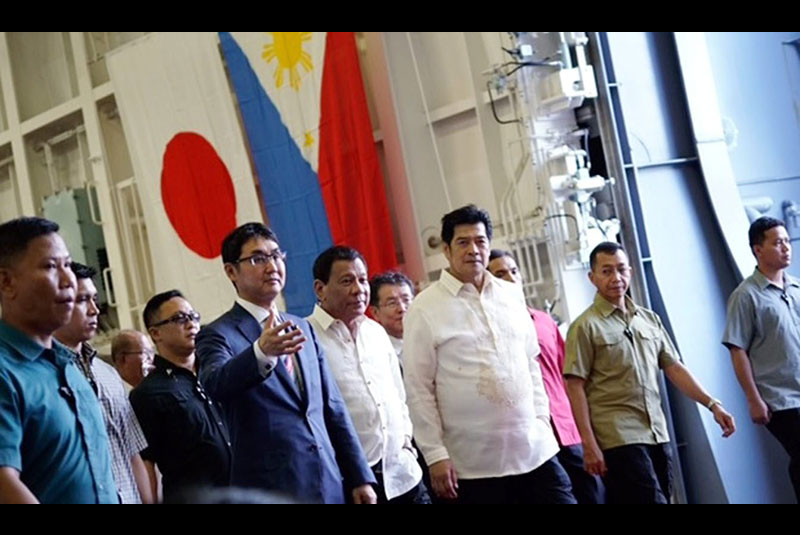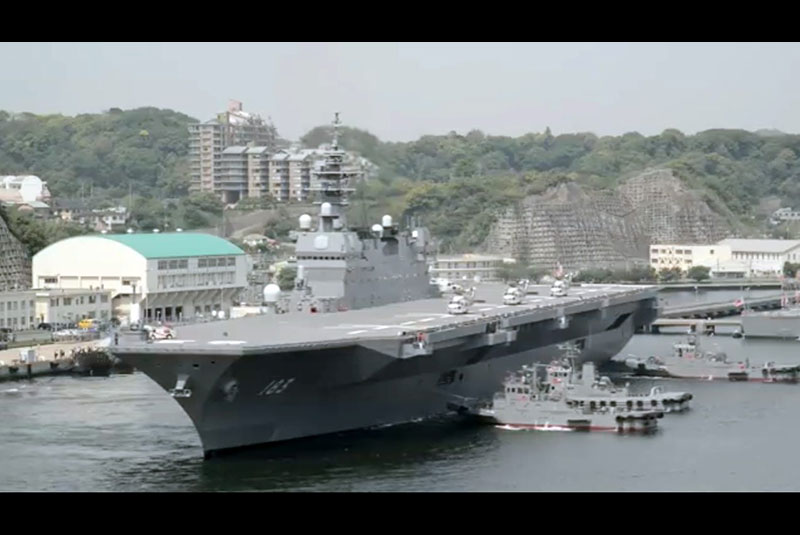Golez: President Duterte visits Japan's largest warship. The Philippines has moved on fully from the bloody war with Japan that started in December 1941. That is good foreign policy. The Philippines should likewise move on fully from the bloody war with America that started in February 1899. Today we face different threats, a different form of invasion, quiet, armed with warships, huge law enforcement ships, and bearing multibillion dollar gifts, but just as dangerous, aiming at permanently occupying our vast West Philippine Sea. We need alliances, new and old.


![]()
Rody feels at home with the Japanese

In spite of his busy schedule attending to various responsibilities, going around camps and visiting soldiers confined at a hospital in Cagayan de Oro City following clashes between government troops and Maute terrorists in Marawi City, President Rodrigo Duterte made every effort to visit Japanese escort ship JS Izumo that was docked at Subic Bay for a four-day goodwill visit.
The President was scheduled to deliver a closing speech during the Nikkei 23rd International Conference on the Future of Asia held on June 5 and 6 which would have also served as an international launch pad for the “Dutertenomics” program of the administration, but he had to cancel his participation due to the conflict in Marawi. President Rody was also supposed to meet with Emperor Akihito during a formal ceremony – probably one of the few that the Japanese monarch will be holding before he abdicates in December next year.
President Rody was also scheduled to meet with Prime Minister Shinzo Abe to discuss the economic and security partnership between the Philippines and Japan. Relations between the two countries have been getting warmer over the years, underscored by the fact that the Philippines’ erstwhile enemy during the second World War has become our top trading partner, with the total bilateral trade estimated at around $18.7 billion or about 14.5 percent of the country’s total trade in 2015.
Japan has also become the biggest contributor of official development assistance (ODA) to the Philippines, with infrastructure projects getting the bulk of funding assistance from the Japanese. For instance, the Japan International Cooperation Agency (JICA) will be financing through ODA the $2.88-billion North-South Commuter Railway (NSCR) Project (extending from Tutuban to Malolos, Bulacan), and the P227-billion Mega Manila subway project. Prime Minister Abe has in fact pledged $8.7 billion (one trillion yen) in ODA and loans to help the Duterte administration’s ambitious infrastructure program.
President Rody is actually the first foreign head of state to visit Izumo – the biggest helicopter destroyer of the Japan Maritime Self Defense Forces (JMSDF). The president, who was accorded military arrival honors by the JMSDF and received a warm welcome by Japanese Ambassador Kazuhide Ishikawa and other members of the Japanese delegation, was given a tour of the ship by Special Adviser to the Prime Minister Katsuyuki Kawai (shown in Presidential Photo courtesy of the Japan embassy).

The president looked very relaxed and at home on board the destroyer, spending more than an hour and a half to visit the command center, the state-of-the-art medical facilities and several other areas. Also with the president and Special Advisor Kawai were Admiral Hiroshi Yamamura, Japan Maritime Self-Defense Forces vice chief of staff.
According to Kawai, Prime Minister Abe extended his wholehearted welcome to the visit of President Duterte to Izumo, expressing hopes that defense cooperation in terms of maritime security will be strengthened considering that “both Japan and the Philippines are maritime states and all national interests derive from the sea.” President Duterte for his part expressed his appreciation and highly commended the superior humanitarian assistance and disaster response (HADR) capability of the ship.
Izumo was commissioned in 2015 and is acknowledged as the lead vessel of the new 27,000-ton Izumo-class of helicopter carriers. Defense experts however say that the Izumo is more than just an escort ship or helicopter destroyer. So far, it is the biggest vessel built by Japan since the second World War and can accommodate more than 20 helicopters on its spacious flight deck.
Described as the pride of Japanese maritime defense, the JS Izumo has been actively going around the region, participating in major naval exercises. It was at Cam Ranh Bay in Vietnam last month for the PP17 (Pacific Partnership 2017) led by the United States with Australia and UK also participating. The PP17 is described as the biggest annual HADR preparedness drill in the Asia Pacific region.
The Chinese are said to be very irritated with Izumo because its name is the same as the flagship of the Japanese fleet during the invasion of China in the 1930s. Defense experts say its classification as an escort ship is meant to tone down its potential warfighting/offensive capabilities which is not allowed under the current pacifist constitution of Japan.
Many also see Izumo (DDH-183) as symbolic of Japan’s evolving military role given the tensions at the South China Sea, North Korea’s continued belligerence and China’s activities concerning disputed territories in SCS as well as the East China Sea, for instance, the Senkaku islands.
Prime Minister Abe has been working hard to amend Article 9 of Japan’s Constitution. As we have noted much earlier, he has been pushing for “proactive pacifism” through the doctrine of “collective self-defense” that would allow Japan to utilize its defense forces during situations that pose a threat to the people and the country itself – like a potential armed attack. The Japanese Parliament in 2015 supported this through various laws and by reinterpreting their Constitution to allow the existence of Japanese self-defense forces – something which past governments have also done.
The Japanese public is evenly divided on the issue, with a recent survey by Nikkei showing that 51 percent of the population backs the initiatives of Prime Minister Abe who likely sees this as a legacy issue that he wants to pursue as his current term ends in September 2018 – although he has a chance to go for a third term until 2021.
***
Email: spybits08@gmail.com
No comments:
Post a Comment